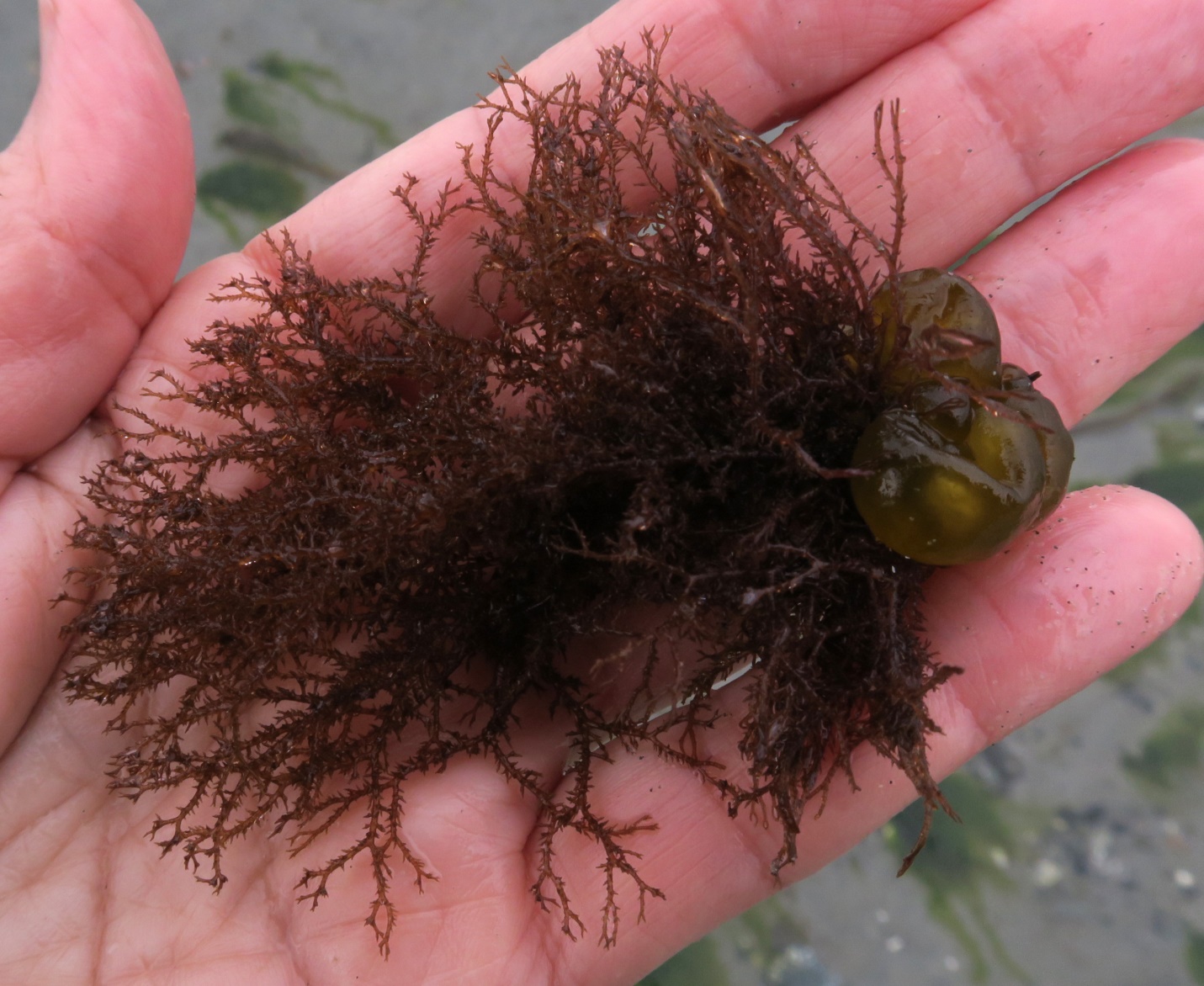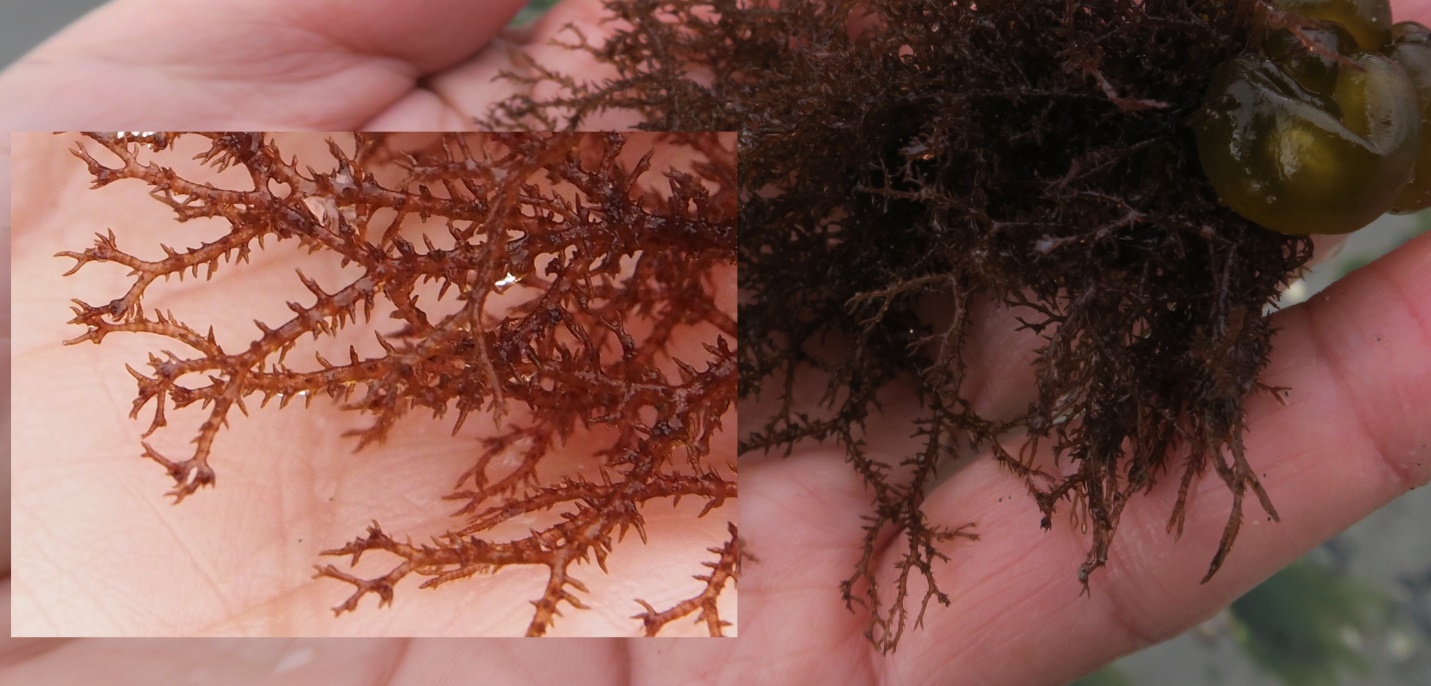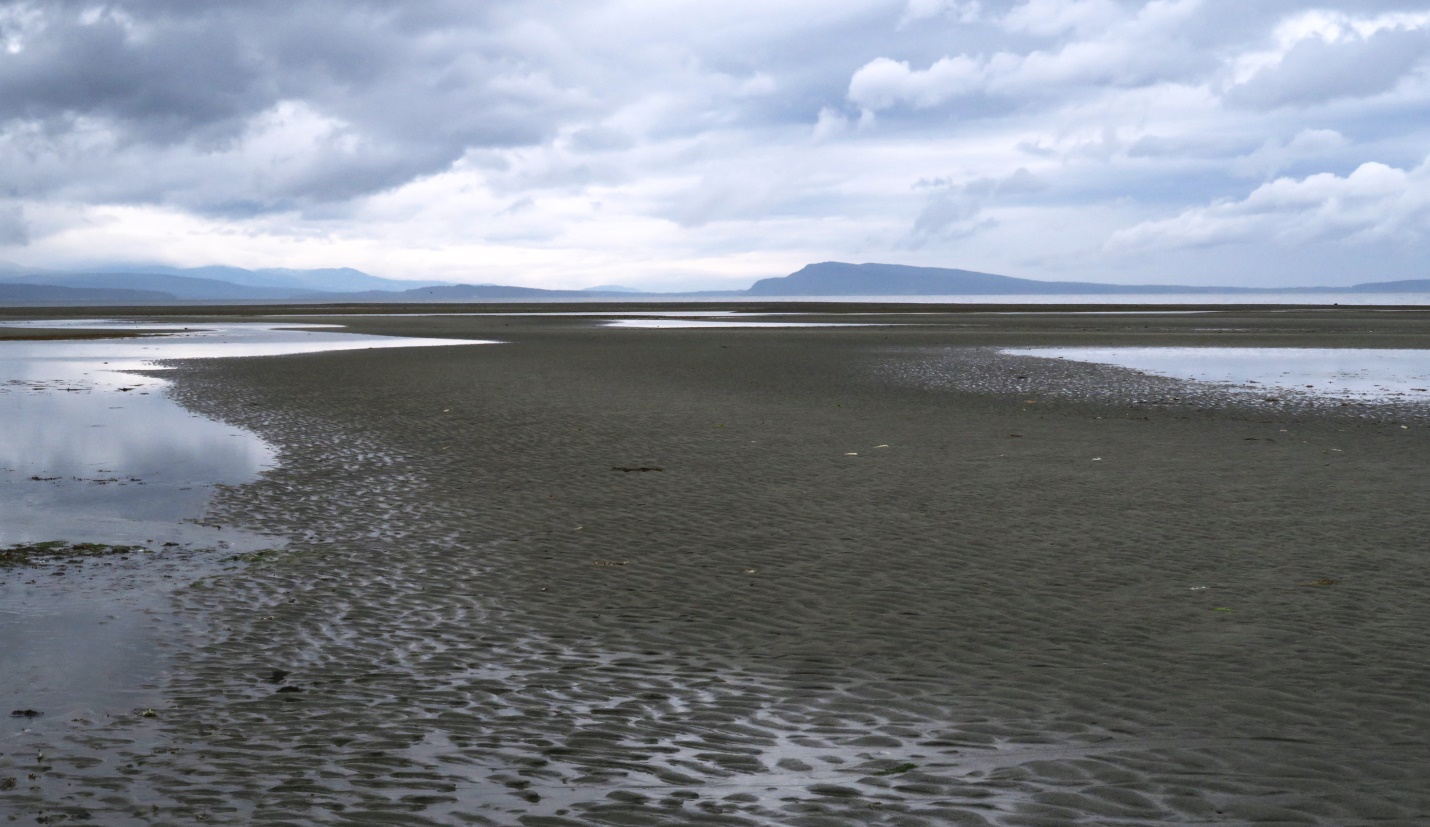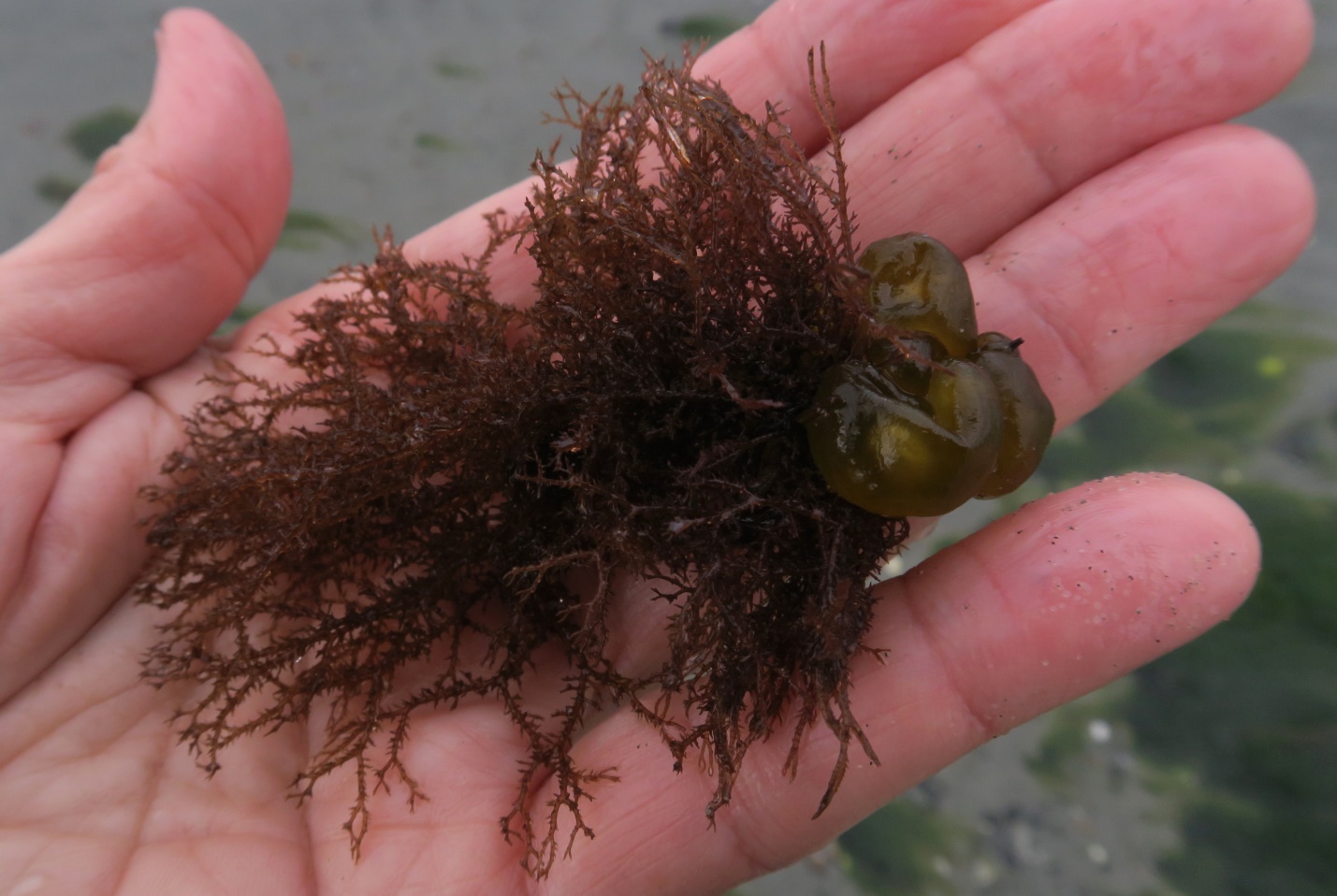
Caulacanthus okamurae
Okamura’s Pom-Pom Weed
28 April 2025
Little Qualicum River Estuary, Strait of Georgia, B.C., Canada
Tide: 1.1 foot low at 12:50 PDT (measured at Winchelsea Island Tidal Station)
Weather: Overcast, occasional showers, wind ESE 15 km/hour, sea choppy, humidity 93%, 11 ˚C.
Moon: Waxing Crescent (1.5%, 1 day); Next phase, First Quarter, 4 May 2025 at 6:51 am PST; Previous Phase, New Moon, 27 April 2025 at 12:31 pm PST.

Figure 1: “Who are you?” A brand new-to-us red algae was found in the drift at Little Qualicum River Estuary beach. It stood up, perky and wiry looking and readily caught our attention. Little Qualicum River Estuary, Strait of Georgia, B.C., Canada. April 28, 2025. Photo ID 27780 ©Seaweedwhisperings.com
Person 1:
Bristly.
Aggressive.
Impatient.
Will snap at you if irritated.
Antisocial.
Uncomfortable in the company of others.
Always wary and defensive.
First instinct is to blame others; unable to look within.
Shallow intellect.
Small-man complex (Napoleon complex, short man syndrome); puts on compensations for its small size.
Ugly in overall appearance, but beautiful when one can see beyond the first impressions.
‘Horns’ remind me of pronghorn antelope.
I had expected to not ‘get’ very much, but was surprised that after a very short interaction I already had found at least six points.

Figure 2: A closer look reveals a combination of features that is distinctly different. The numerous ‘spines’ combined with the ‘horn-tips’ of many branches helped identify this as Caulacanthus okamurae – a native to Asia and first found in Japan, it is now at home in British Columbia, too. Little Qualicum River Estuary, Strait of Georgia, B.C., Canada. April 28, 2025. Photo ID 27781 ©Seaweedwhisperings.com
Person 2:
Walking out onto the sandy expanse of the beach at Little Qualicum Estuary this day, we got past the first set of shallow tide pools and followed the rise of the substrate along another large and long pool that was gently draining into the strait.
It wasn’t long at all before a little clump of red algae caught my attention.
It certainly was ‘little’ in overall size – the entire unbroken cluster fit in the palm of my hand.
And it was sitting really quite perkily there on the sandy beach, resting above the water line as the tide continued to recede.
It looked different.
It brought up the question, “Hey, who are you?” And the thought, “I don’t think I’ve met you before.”
It was unlike other seaweeds I’ve seen here, maybe anywhere, before.
You are little in size, Caulacanthus okamurae, yes you are, and you’re making a strong impression. It struck me that seen even from a distance where no details were truly discernable yet visually, the overall look and energy of this seaweed still came across as notably different.
With an up close look I could gather more impressions.
It appears that this seaweed ‘traveled’ to this location courtesy of the ‘lift’ from the three small Colpomenia peregrina “floats”. I can’t tell if the Colpomenia floats lifted the Caulacanthus from its holdfast, or if the Caulacanthus began life choosing to grow epiphytically on the Colpomenia. Whatever the origins of their association it now is irrelevant – their fates are intertwined.
Caulacanthus looks very spiny, and that effect is enhanced at the branch tips which terminate with a set of pointed ‘horns’.
Its spines make one think of nail brush seaweed – Endocladia muricata, but not quite; and its rounded cluster form and translucent stems along with its ‘hitching a ride to new places’ aspect reminds one of Yendoa hakodatensis, but, again not quite. It is neither; it is its own self, its own species. And this is the first time we have encountered it.
We had just barely begun heading out for our explorations and very quickly we encountered this new seaweed. This felt like a notable aspect to the energy of Caulacanthus; that it can suddenly be at center stage, and this can happen involuntarily, without it even trying to be there.
Even though it has spines and horns, to me this was not a ‘nasty’ look; it was more that it was distinctive. I felt that it presents with its character right up front – obvious and plain for all to see.
I considered its arrival here, in effect, by having taken a ride on the Colpomenia ‘floats’. Colpomenia’s reliable ‘lift’ and cooperation with the forces of ocean currents meant this little seaweed had been very effectively transported away to a whole new region and I felt that Caulacanthus, in this instance at least, had chosen to take the situation right in stride. It was alert and perky and also was encountering this brand new place with a cheerfully feisty attitude. And, if Caulacanthus felt any fear or uncertainty, their horns and spines might serve to shore them up until their courage is once again restored.

Figure 3: The inset image is much larger than life size; if you look at the branch tips on the left of the image you will see some of the “horns” that are part of the morphology of Caulacanthus okamurae. Once you spot them there, you will see the horns in other places and they add a ‘characteristic’ to this red alga that helps one know that while it may be small, it is also tough. Little Qualicum River Estuary, Strait of Georgia, B.C., Canada. April 28, 2025. Photo ID 27782 ©Seaweedwhisperings.com
Discussion:
We compared observations, and were immediately struck by something obvious – we were seeing pretty much the opposite characteristics of this seaweed. Wary or courageous, irritable or perky, aggressive or cheerful --- these all felt rather unalike. Also distinctive was that some of these traits were registered even from a distance, clearly recognizable without having to investigate closely.
The contrast seemed big; almost like we met two very different persons, or one person presenting very different aspects of themselves. This brought to mind the theatre ‘symbol’ involving two masks, one representing comedy and the other tragedy. History tells that such masks were used, going all the way back to Ancient Greece, to represent the emotions of characters in a theatrical performance. Use of masks meant that the audience, even those seated at some distance from the stage, would make no mistake about what was being portrayed by the actors. Masks also allowed the male-only actors to present as female characters.
These dramatic differences could also reflect the variation between how Caulacanthus feels internally, and how Caulacanthus is often perceived by others from the outside.
The pronghorn, Antilocapra americana, is a good analogy for this seaweed; they are built to move and are the second fastest land animal on earth. Sustained speeds of the pronghorn are actually greater than those of the cheetah (the fastest land animal). This seaweed has this same type of ability; it is prepared to “run” at a moment’s notice and to do so with complete ease and notable speed.
Sometimes where it runs to can prove to be a trap or a rather rude surprise, and then they need their bristly, spiny, horns-facing-out-towards-others character in place. Other times, the “run” is an experience of exhilarating freedom and we see a vivacity to them that is striking.
Not quite Endocladia, not quite Yendoa; it’s neither – and the question comes up, “Who are you?” So, sometimes they are not well known in their own right. Maybe they can slip by, like being in disguise or wearing a mask.
What purpose does this serve – being unknown and slipping by unrecognized? One plus is that they can go along their chosen path without being interfered with, without the suggestions or warnings others might toss their way.
At other times not being seen for who they are, their unique-species self, grates at Caulacanthus quite deeply. They feel almost as if they have to prove who they are when they feel that they are already plainly presenting that quite adequately, thank you very much! They would much rather pour their energy into what they are up to in life, but somehow this ‘proving’ aspect keeps confronting them.
Just barely heading out and “boom!” --- something brand new presents itself. And, only a short interaction easily yields many character traits. What exactly is that?
We felt it has something to do their speed, they are typically moving fast, like they’re really going somewhere with their engines operating at ‘warp-speed’. And for Caulacanthus okamurae this is not a random or impulsive “run”; this is about moving with clear intention and with their full power committed to the run.
There is a clear energy that emits from that; this movement that has such clear intent and strong dedication behind it, and we felt that this is one way that something that moves with speed can clearly impart who they are. Like seeing a herd of startled pronghorn running across the prairie, you catch a glance at them moving and you know they’re pronghorn. They’re moving so fast you truly don’t know how you’re registering enough details to identify them, yet truly there is no confusion at all. It’s like they’ve got on their ‘I-am-pronghorn’ theatre mask and it can be interpreted from miles away.
Shallow intellect – this comment sounds critical, a bit harsh or insulting..., but we think what it was indicating to us is that this energy is one that still regularly employs something in addition to intellect or in preference to intellect, and that is their strong connection to pure instinct. One example can be the hormones that signal danger without need for conscious thought – it is that kind of no-need-for-the-intellect situation that they can excel at. Therefore Caulacanthus energy is one that can do well in circumstances requiring courage and daring and quick and accurate responses; others who need to first carefully evaluate with conscious consideration and measured risk evaluations, well, they will be left in the dust in comparison.
To others it could seem that they must “cheat” in their arrival at certain places or accomplishing certain feats, asking, “How did they do that?” Caulacanthus simply went with their instincts and landed in the suitable position with the right skills and determination to meet the circumstances. This often can happen quickly, long before others have got themselves organized to even consider their options. Of course this doesn’t happen in every instance, but when it does there can be a feeling in others that Caulacanthus had an unfair advantage. There can be amazement or almost disbelief felt by others at the speed with which Caulacanthus can arrive at new situations and fully engage themselves there.
And for Caulacanthus there can be the reality that with what they chose to do, for example to connect with and grow together with some Colpomenia peregrina seaweed, their initial choice can sometimes become something that they later will not or cannot turn away from. They are committed and for them there quite simply is no turning back. This can demand that they draw on whatever reserves of courage and fortitude that they possess to meet what they’re facing as well as they can.

Figure 4: A little seaweed makes a strong impression upon newly “landing” at this location. How different is this vast expanse of sand and sea compared to where it started from, and how big a change is it being asked to make as it carries on with life here at Little Qualicum Estuary? A known transoceanic settler, we expect Caulacanthus okamurae will do very well indeed. Little Qualicum River Estuary, Strait of Georgia, B.C., Canada. April 28, 2025. Photo ID 27783 ©Seaweedwhisperings.com
Biology & Natural History:
Description:
Caulacanthus okamurae is a densely tufted, dark purple to brown, profusely and irregular to sub-dichotomously branched alga. The cartilaginous fronds form turfs in the mid-intertidal zone and generally grow to about 30 mm long. Somewhat resembling another turf forming red alga, Endocladia muricata, this seaweed has branches that are covered with very small curved branches that are spine-like, however in C. okamurae the ‘spines’ are larger and present more prominently. It has another distinguishing feature, many of the branch tips are reflexed, narrowing abruptly towards the apices, resulting in a horn-like appearance. It attaches to the substrate via creeping stolons producing multicellular rhizoids. Cystocarps occur on the tips of the finest branchlets.
Habitat:
Mid intertidal zone of exposed rocky coasts and more sheltered areas. It can be found growing on rock in and amongst barnacles, mixed in with other mid intertidal algae, as well as epiphytic on mussels and fucoids.
World Distribution:
Native Pacific populations are widely distributed in China, Japan and Korea. C. okamurae has a broad transoceanic distribution in the Northern Hemisphere including France, Spain, Italy, Canada and the USA.
Remarks:
Caulacanthus okamurae was first described from Japan and is known now to be native to Japan, China, Taiwan and Korea. It was reported in Brittany in 1986 and it spread widely there as well as in Ormandy. Other introduced populations were then found in S and SW Britain and Spain. In Atlantic Spain it overlaps with a native species, Caulacanthus ustulatus, often occurring at the same tide level and on the same shore. Initially in Atlantic France, the Netherlands and Britain, C. okamurae was erroneously referred to as Caulacanthus ustulatus.
Classification:
Phylum: Rhodophyta
Class: Florideophyceae
Subclass: Rhodymeniophycidae
Order: Gigartinales
Family: Caulacanthaceae
Genus: Caulacanthus
Species: Caulacanthus okamurae Yamada 1933
Former name(s): none

Figure 5: One last view of Caulacanthus okamurae, a seaweed we expect to be encountering more of in the coming years. The round olive brown floats of the Oyster Thief Seaweed, Colpomenia peregrina, surely aided in transporting this particular individual to a new location, but research tells us that other vectors probably include hull-fouling, ballast water release and oyster-culturing. Qualicum River Estuary, Strait of Georgia, B.C., Canada. April 28, 2025. Photo ID 27784 ©Seaweedwhisperings.com
![]()